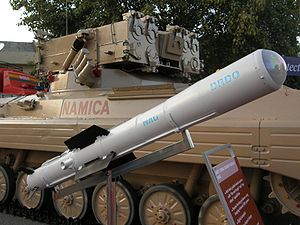Nag
Nag (Sanskrit: नाग, Nāg "Snake") is a third generation "Fire-and-forget" anti-tank missile developed in India. It is one of five missile systems developed by the Defence Research and Development Organisation (DRDO) under the Integrated Guided Missile Development Program (IGMDP). Nag has been developed at a cost of
| Nag | |
|---|---|
 Nag missile with the NAMICA in the background. Picture taken during DEFEXPO-2008. | |
| Type | Anti-tank guided missile |
| Place of origin | |
| Service history | |
| In service | 2009 |
| Production history | |
| Manufacturer | Bharat Dynamics Limited (BDL) |
| Specifications | |
| Weight | 42 kg (93 lb) |
| Length | 1.90 m (6'3") |
| Diameter | 190 mm (7.5 in) |
| Warhead | 8 kg (17.6 lb) tandem warhead |
| Engine | Tandem solid Propulsion (Nitramine based smokeless extruded double band sustainer propellant) |
| Wingspan | 400 mm |
| Operational range | Land version: 500m to 4km (Air launched: 7km) |
| Speed | 230 m/s |
| Guidance system | Active Imaging infra-red (IIR) seeker,millimetric wave (mmW) seeker (under development) |
| Launch platform | Nag Missile Carrier (NAMICA)HAL Dhruv HelicopterHAL Light Combat Helicopter |
Technical Characteristics
As originally conceived, the Nag would have been available with three different types of guidance, These included a wire guided version, an infra-red version and a millimetric wave (mmW) version. The cumbersome nature of a wire guidance system had led to plans for this being dropped. Currently, guidance is based on an imaging infra-red (IIR) passive seeker that ensures a high-hit accuracy in both top- and front-attack modes.The mmW seeker, on the other hand, is intended to operate as an optional system that can replace the IIR passive seeker as a module. Also incorporated into the guidance system, is a CCD camera. The advantage of this optical seeker is that it is less prone to jamming. The missile has a weight of 42 kg and can engage targets at ranges 4–5 km. The Nag is claimed to be first anti-tank missile which has a complete fiberglass structure.
Another advantage of the missile is property of the propellant. Most missiles leave a plume as the missile heads toward the target. This makes it easier for the target to hide behind cover. In the Nag, however, the plume is visible only during the first one second of flight, as the missile's booster imparts 90% of the velocity, following which, a sustainer maintains the missile's speed, burning a smokeless propellant that is almost invisible.
The Nag has a flight speed of 230 metres per second, is armed with a 8 kg tandem shaped-charge warhead, has a rocket motor using nitramine-based smokeless extruded double band sustainer propellant, has a single-shot hit probability of 0.77 and a CEP of 0.9 metres, and has a 10-year maintenance-free shelf-life.Recently,it was tested from Shamirpet in hyderabad on june 13,2010.
The Nag will be produced in two main basic variants. The land version has been tested from a tracked vehicle known as NAMICA (Nag Missile Carrier). With the IR version of the missile, targets are acquired using a thermal sight, and are then assigned to the nose-mounted IIR seeker.
Missile guidance is initially by area correlation around the target, then by centroid tracking. Terminal homing is by area correlation around the centroid.
Nag will be configured to be used on the Advanced Light Helicopter(ALH) and the HAL Light Combat Helicopter(LCH). This version will be known as HELINA (HELIcopter NAg). Eight missiles are carried in two quadruple launchers. Launchers mounted on either side are linked to a nose-mounted stabilized thermal sight and a laser range-finder package.
The NAMICA version of the missile is a 'lock-on before launch' system. This is where the target is identified and designated before the missile is launched. As the targeting system is based on visual identification, the range is limited. The HELINA version on the other hand will use a 'lock-on after launch' system extending its range to 7 km. In this scenario, the missile is launched in the general direction of the target. As it approaches the target, images of the area ahead are sent back to the operator who will be able to identify enemy tanks. The command to lock on to a tank is then passed onto the seeker through an uplink mid-flight. After that, the missile homes in onto the target and destroys it.
Advanced Variants
In addition to basic land and helicopter variants the DRDO is now developing number of advanced variants of the Nag missile:- Helina, (HELIcopter launched NAg)with a range of 7–8 km, launched from twin-tube stub wing-mounted launchers on board the armed HAL Dhruv and HAL Light Combat Helicopter produced by state-owned Hindustan Aeronautics Ltd (HAL). It will be structurally different from the Nag. The Helina will make use of an IIR seeker for target engagement like the Nag. Launchers have been cleared for captive carriage trials and handed over to Hindustan Aeronautics Limited (HAL) for carriage trials. The Helina is expected to be tested by the end of 2010.
- land version, will also have its range extended by development of a mast-mounted missile launcher that will be hydraulically raised out to a height of five metres to enable the Nag missile to acquire its targets out to a distance of 7–8 km.
- Air-launched, 10 km-range variant launched from tactical interdiction aircraft like the upgraded Jaguar IS. It will use a nose-mounted millimetric-wave active radar seeker.
- Man portable, DRDL will also start working on the,`Man Portable' Nag very soon. It would weigh less than 14 kg.

No comments:
Post a Comment